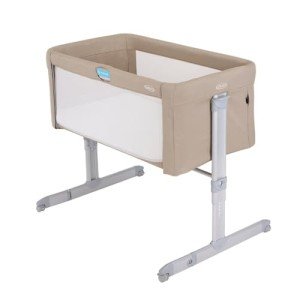Understanding Co-Sleeper Cribs: A Comprehensive Guide for New Parents
In the ever-evolving landscape of infant sleep options, co-sleeper cribs have actually amassed substantial attention among new parents. These specialized cribs provide a distinct bridge between co-sleeping and safe sleep practices, providing benefits that resonate with both caregivers and infants. This article looks into the complexities of co-sleeper cribs, describing their features, advantages, factors to consider, and answering common questions to guide parents in making a notified choice.
What is a Co-Sleeper Crib?
A co-sleeper crib, likewise referred to as a bedside sleeper, is a type of crib created to securely connect or sit beside an adult bed. www.cots4tots.co.uk permits infants to sleep near their parents without the dangers generally connected with adult bed-sharing. These cribs come in various styles, however most share an essential feature: one side that is lower, enabling easy reach to the baby while keeping them in their own designated sleeping space.
Secret Features of Co-Sleeper Cribs
- Safe Attachment: Designed to safely connect to the adult bed, ensuring stability.
- Adjustable Height: Height personalization options for seamless positioning next to the adult mattress.
- Breathable Mesh Sides: Often geared up with breathable mesh sides to improve airflow.
- Compact Design: Takes up less space than traditional cribs, making them perfect for small spaces.
- Portable Options: Many co-sleeper cribs are light-weight or foldable, enabling easy motion and travel.
Advantages of Using a Co-Sleeper Crib
Co-sleeper cribs present a number of advantages that attract new parents, including:
- Enhanced Bonding: Proximity promotes bonding and can relieve nighttime feedings and soothing.
- Streamlined Nighttime Feeding: Parents can quickly feed or relieve their baby without needing to rise.
- Reduced Risk of Bed-Sharing Hazards: Co-sleepers produce a safer environment than traditional bed-sharing, lowering the threat of suffocation and falls.
- Support of Independent Sleep: Infants have their own sleep space, which promotes independent sleeping habits.
Considerations When Choosing a Co-Sleeper Crib
While co-sleeper cribs offer numerous advantages, there are also several factors to consider that parents must examine before making a purchase:
- Safety Standards: Always guarantee that the crib adheres to present security policies supplied by companies such as the Consumer Product Safety Commission (CPSC).
- Size Compatibility: Measure the adult bed to make sure the co-sleeper will fit securely and easily alongside it.
- Ease of Use: Look for models that facilitate easy operation and availability, especially during nighttime.
- Convertible Options: Some co-sleepers use the flexibility to convert into a standard crib once the kid outgrows them, which can be a cost-efficient choice.
Leading Co-Sleeper Cribs on the Market
To assist browse the abundance of choices offered, here's a table showcasing some popular co-sleeper cribs together with their standout functions:
| Brand | Design | Features | Cost Range |
|---|---|---|---|
| Arm's Reach | Suitable Arc Crib | Adjustable height, detachable side | ₤ 150 - ₤ 230 |
| Babybay | Initial Co-Sleeper | Made from sustainable wood, consists of bed mattress | ₤ 240 - ₤ 300 |
| Chicco | Next2Me Magic | Easy side access, foldable design | ₤ 200 - ₤ 280 |
| Snuggle Me | Organic Co-Sleeper | Soft, comfortable contours; portable | ₤ 120 - ₤ 180 |
| HALO | BassiNest | 360-degree swiveling, height-adjustable | ₤ 250 - ₤ 350 |
Tips for Using a Co-Sleeper Crib
- Positioning: Place the co-sleeper beside the bed at the exact same height level for security.
- Follow Safe Sleep Practices: Ensure the crib is established according to standards to lessen risks. This consists of avoiding loose bedding and keeping the mattress company.
- Routinely Check Security: Periodically examine the attachment in between the co-sleeper and the adult bed to guarantee it remains protected and stable.
Regularly Asked Questions (FAQs)
1. Are co-sleeper cribs safe?Yes, when
utilized according to the maker's directions and security standards, co-sleeper cribs are considered a safe option to standard bed-sharing.
2. The length of time can my baby use a co-sleeper crib?Most co-sleeper cribs are developed for infants approximately 5-6 months old, however examine private item specs for age and weight limitations. 3. Do co-sleeper cribs feature mattresses?Many co-sleeper cribs feature included mattresses, but verify this before purchase. Guarantee any extra mattress satisfies safety standards. 4. Can a co-sleeper crib be used for twins?There are co-sleeper cribs created for twins, but these designs may be less common. Always examine the size and weight limits. 5. Ought to I use a co-sleeper crib for naps?Absolutely! Co-sleepers work well for both nighttime sleeping and naps, supplying a consistent sleep environment for infants. Co-sleeper cribs use an efficient and safe compromise
for new parents eager to keep their infant close while preserving a safe and secure sleeping environment. By comprehending their functions, advantages, and
safety considerations, parents can make informed choices that cater to their family's requirements. Whether you're searching for benefit during nighttime feedings or a way to build a strong early bond, a co-sleeper crib may simply be the right option for you and your kid.

